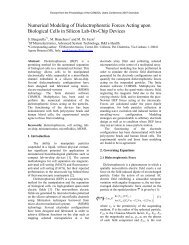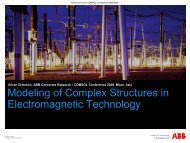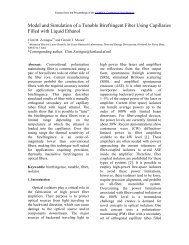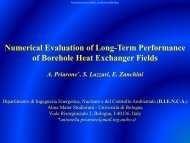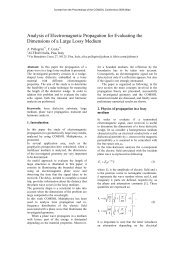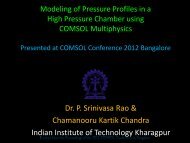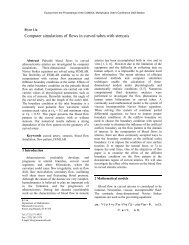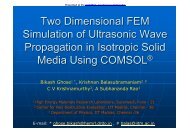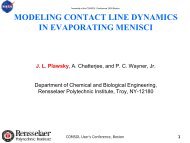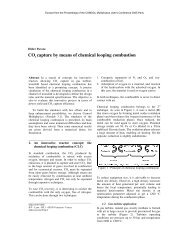[PDF] Modelling of seismoelectric effects - COMSOL.com
[PDF] Modelling of seismoelectric effects - COMSOL.com
[PDF] Modelling of seismoelectric effects - COMSOL.com
You also want an ePaper? Increase the reach of your titles
YUMPU automatically turns print PDFs into web optimized ePapers that Google loves.
solid phase u and the pore pressure p as the<br />
essential variables and called this the "u-p<br />
formulation". Following this assumption, we<br />
here introduce a simplified poroelastic model for<br />
the <strong>seismoelectric</strong> <strong>effects</strong> directly in the time<br />
domain. Using a low-frequency approximation,<br />
the saturated rock/soil system is modelled as a<br />
two-phase material based on the linear<br />
poroelasticity theory for porous media (Wang<br />
2000). Introducing the stress-strain relationship<br />
plus an incremental change caused by variation<br />
<strong>of</strong> the fluid pressure leads to the constitutive<br />
equation for poroelasticity. The equilibrium<br />
conditions for volume elements <strong>com</strong>bined with<br />
Hooke`s extended law for poroelastic bodies can<br />
then be recast as follows:<br />
displacement current ∂D/∂t can be neglected<br />
relative to the conduction current density<br />
because ωε/σ < 10 -4 for seismic frequencies and<br />
materials <strong>of</strong> interest (Haines and Pride, 2006).<br />
For TIP, the interaction <strong>of</strong> coupled and direct<br />
fluxes leads to so-called electrokinetic<br />
phenomena (e.g. De Groot 1960; Groot and<br />
Mazur, 1984). The thermodynamic fluxes<br />
associated with electrokinetic phenomena (fluid<br />
velocity and electrical current density) can be<br />
derived in thermodynamic non-equilibrium as a<br />
linear <strong>com</strong>bination <strong>of</strong> thermodynamic forces<br />
(hydraulic potential gradient and electrical<br />
potential gradient). The laws controlling linear<br />
transport in porous media in the presence <strong>of</strong><br />
electrokinetic coupling are:<br />
where G is the shear modulus <strong>of</strong> the solid frame,<br />
α the effective stress coefficient (Biot-Willis<br />
coefficient), p the excess pore pressure, ν the<br />
Poisson number, u the total displacement, w the<br />
relative displacement between fluid and matrix, ρ<br />
the bulk density, and ρ f the fluid density.<br />
For the description <strong>of</strong> the electromagnetic<br />
response <strong>of</strong> the system Maxwell`s equations are<br />
used. In the case <strong>of</strong> a time-dependent electric<br />
field Faraday’s law states:<br />
where E is the electric field strength, H is the<br />
magnetic field strength, and μ the magnetic<br />
permeability.<br />
The magnetic field caused by an<br />
electrokinetic system can be described by<br />
Ampere`s law:<br />
where D is the electric displacement, j the total<br />
current density, and σ the electrical conductivity.<br />
The total current density in equation (3) is<br />
<strong>com</strong>posed <strong>of</strong> a conduction current density σE<br />
and a current density L∇p caused by charges<br />
being dragged by the flowing fluid; the<br />
corresponding electric potential is well known as<br />
the streaming potential (e.g. Wurmstich and<br />
Morgan 1994; Pride 1994). The dielectric<br />
The first term on the right-hand side <strong>of</strong><br />
equation (4) describes Darcy’s law for the<br />
hydraulic flow <strong>of</strong> a fluid with the specific flux q,<br />
the dynamic viscosity η in a porous rock matrix<br />
<strong>of</strong> hydraulic conductivity k driven by a pressure<br />
gradient. This dynamic flux must be extended<br />
with respect to pressure differences in the fluid<br />
caused by the seismic disturbances (Biot 1956a).<br />
The second term on the right-hand side <strong>of</strong><br />
equation (5) represents Ohm’s law and describes<br />
the electrical current caused by an electric<br />
potential gradient (voltage) in a conductive<br />
medium. The remaining terms, which couple the<br />
two phenomena, represent the electroosmotic<br />
drag exerted on the hydraulic flow caused by the<br />
electric voltage and the electrokinetic current<br />
density (associated with streaming potential),<br />
which is also extended because <strong>of</strong> the pressure<br />
differences in the fluid (Wurmstich and Morgan,<br />
1994). Equation (5) is valid under the<br />
assumption <strong>of</strong> absence <strong>of</strong> external sources in the<br />
system, i.e. . The electrical conductivity<br />
is given by , where σ f is the fluid<br />
conductivity and F 0 is the formation factor.<br />
The coupling coefficient L ("Onsager<br />
coefficient") is dependent on the dielectric<br />
permittivity ε 0 <strong>of</strong> the fluid, the zeta potential<br />
associated with the mineral-fluid interface, the<br />
formation factor F 0 and the viscosity η:


![[PDF] Modelling of seismoelectric effects - COMSOL.com](https://img.yumpu.com/35231397/2/500x640/pdf-modelling-of-seismoelectric-effects-comsolcom.jpg)
![[PDF] Microsoft Word - paper.docx - COMSOL.com](https://img.yumpu.com/50367802/1/184x260/pdf-microsoft-word-paperdocx-comsolcom.jpg?quality=85)
